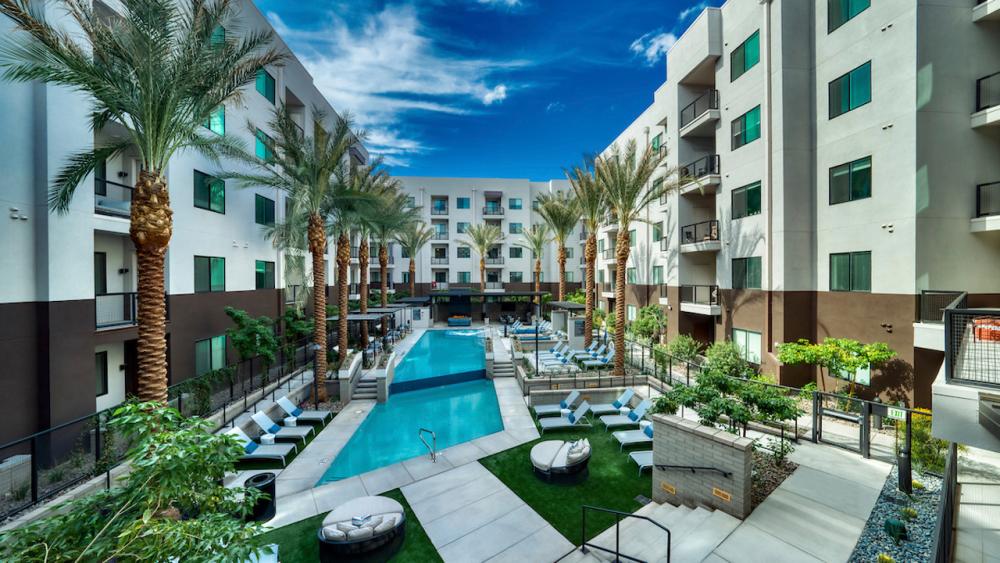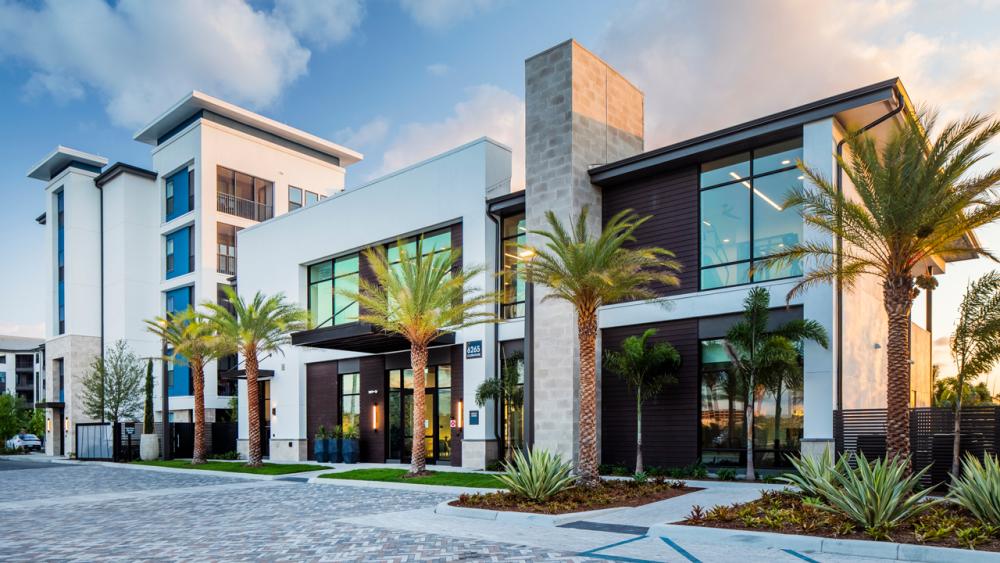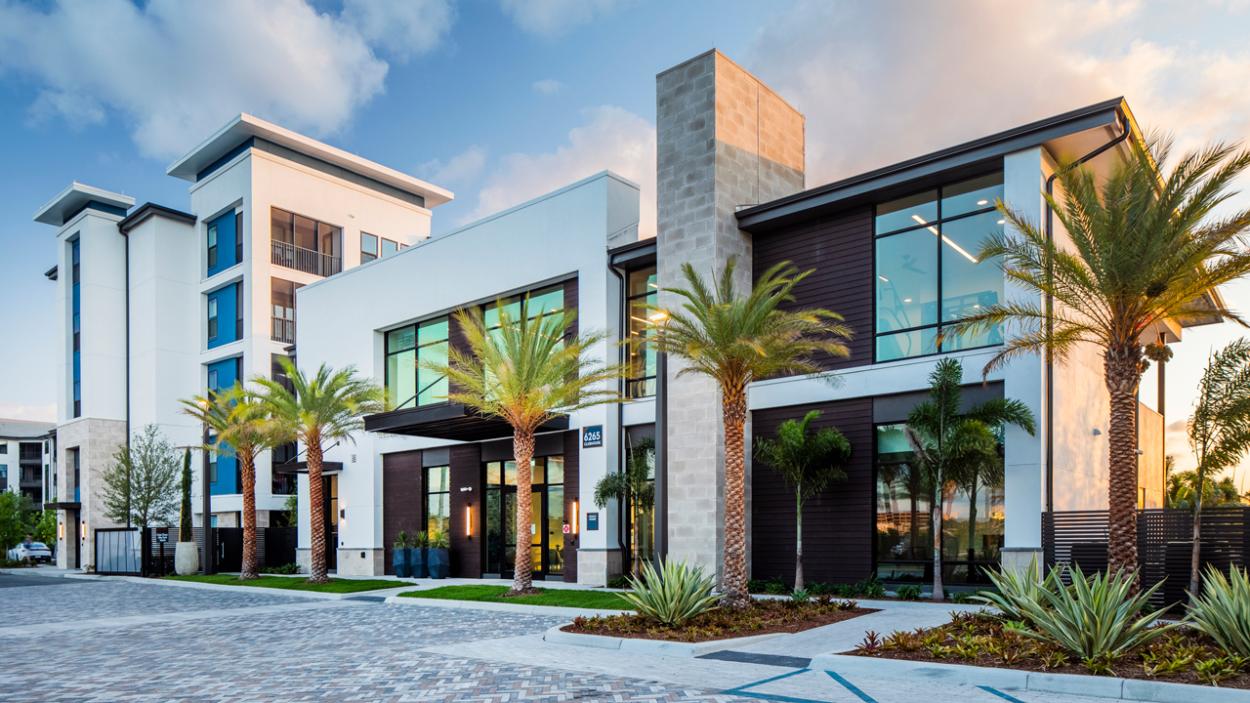
Three decades on from its listing as a public company, MAA (NYSE: MAA) remains committed to its original focus on the Sun Belt, a region that has propelled the REIT’s growth over the years. And while supply pressures have emerged, they are nothing new, says CEO Eric Bolton, who sees a range of factors combining to support steady demand for apartment housing in the years ahead.
Underpinned by its Sun Belt exposure, Tennessee-based MAA has grown from its IPO value of nearly $91 million in 1994 to an equity market capitalization of approximately $16 billion today. The company, a member of the S&P 500, owns 102,662 units across 16 states and the District of Columbia, making it the largest publicly traded apartment REIT in the U.S. based on the number of units.
For the past 30 years, MAA’s approach has been to stay a pure-play apartment REIT with strategic diversity in large and secondary markets primarily across the high-growth Sun Belt region. “We were in the Sun Belt before it became cool, and we’re in more markets across the region than any of our peers,” Bolton says.
While many other operators and investors were targeting coastal markets, MAA was locked in on high growth markets, giving the company a leg up on impending competition. “More recently, everybody has begun to appreciate the growth dynamics of this region, and we've seen a lot more competitors,” he adds.
Growth from Mergers
MAA’s strong performance and geographic focus has not gone unnoticed.
“Twenty years ago, the multiples that the Sun Belt apartment REITs commanded versus the coastal apartment REITs were about half,” says Alexander Goldfarb, senior REIT equity research analyst at Piper Sandler. “Over the past two decades, the Sun Belt apartment REITs have not only closed that gap, but sometimes will trade at a premium to the coastal apartment companies. That’s truly incredible, and it's a testament to MAA for demonstrating that NOI growth, dividend growth, and NAV growth are independent of whether you're located in Texas or California. It's driven by your competitive position.”

MAA started as The Cates Co. in 1977, founded by the late George Cates. He took the company public under the name Mid-America Apartment Communities, raising $175 million from shareholders. Bolton joined MAA shortly after the IPO as vice president of development and then COO. He became CEO when Cates retired in 2001.
Bolton led two large-scale mergers to continue fueling growth. In 2013, MAA acquired competitor Birmingham, Alabama-based Colonial Properties Trust for $2.2 billion. The acquisition boosted MAA’s portfolio to 85,000 units in 285 properties across the Sun Belt.
Then in 2016, MAA acquired another competitor, Atlanta-based Post Properties Inc., in an all-stock deal valued at $3.8 billion. The combined portfolios boasted 317 properties totaling 105,000 units across the Sun Belt, creating an apartment dynamo. The deal further boosted MAA’s balance sheet, expanded its portfolio diversification, and brought development expertise in-house.
Delivery Pressure
While the Sun Belt market was red-hot for the past several years, it’s been cooling as record-high deliveries impact rent growth. However, demand drivers remain, says Brad Hill, MAA’s president and chief investment officer. MAA, he notes, is well-positioned to compete and fundamentals are expected to improve later this year, leading to enhanced rent growth and value.

“We're seeing the demand side hold up well, whether it's job growth, migration trends, low resident turnover, or new household formations renting apartments,” Hill explains. “Our strategy is to allocate our capital where we believe the highest demand will be over the long term.”
Periodically, Hill says, supply pressure can outpace demand, which typically lasts a few quarters.
“We saw new construction starts because of record levels of capital made available at very low interest rates,” Hill says. “We saw supply deliveries increase in the fourth quarter of 2023, and we're still at that elevated level. We think that continues until mid-year, and then we should start to trend down the back half of this year into 2025 and 2026.”
Increased competition, meanwhile, resulted in a decline in new lease pricing. MAA’s new lease rates dropped 5.5% as of February. However, renewals were up 5.2%. Also, the portfolio saw record-low move-outs. Hill expects new lease pricing performance to improve as deliveries moderate. Renewals are expected to remain in the 4.5% to 5% range in 2024, at a time when MAA’s portfolio occupancy is 95.2%.
Mitigating Risk
For Bolton, supply issues are hardly a new speedbump.
"We’ve seen this supply story many times over the past 30 years,” Bolton says. “New supply is really just competition. As I tell investors and shareholders, I've never worried about supply pressure that comes from time to time. There are things that we can do to help mitigate that pressure for those few quarters when it weighs on performance.”
To mitigate risks, MAA intentionally bifurcates its portfolio between large-tier markets like Dallas and Atlanta and more mid-tier markets like Charleston and Greenville, South Carolina. Currently, 70% of its portfolio is in large markets and 30% is in mid-tier ones.

“We find that this mix brings some stabilizing performance to the portfolio as mid-tier markets don't see quite the levels of new supply as larger cities,” Bolton says.
The company’s secondary markets–including Charleston and Greenville, South Carolina; Savannah, Georgia; and Richmond, Virginia--led the portfolio in lease-over-lease pricing performance in the fourth quarter of 2023, as they experienced less supply than the bigger metros.
MAA also diversifies through property types (garden style, high-rise, and mid-rise), submarkets (inner loop and suburban), and renter price points.
Advantages of Scale
Bolton says the strength of its platform and scale advantages also provide downside protection as compared to other owner/operators invested in their markets.
Being a big player also means being an all-cash buyer. Furthermore, the softer market poses opportunities for MAA to buy assets at below replacement costs.
For example, MAA purchased two new Sun Belt communities in the fourth quarter of 2023, totaling $209 million (in Charlotte, North Carolina, and Phoenix). Both transactions closed at 15% below replacement cost. Both were all-cash deals and acquired during lease up. MAA has budgeted $400 million in 2024 to take advantage of opportunistic acquisitions.
Meanwhile, MAA has a development pipeline that could approach $1 billion in 2024. Currently, five projects are under construction, totaling roughly $650 million. The company also owns 13 land sites entitled for up to 3,500 units.
While MAA continues to expand through development and acquisition, it’s also bolstering its bottom line through a robust redevelopment program. MAA has invested millions to renovate properties to attract and retain renters and drive rent growth. The company currently has identified 13,000 units for renovation.

Strategic updates to individual apartments deliver big returns on investment, according to Hill. For example, MAA completed improvements on 1,394 units in the fourth quarter of 2023, providing a 6% increase in rental rates for those units and well ahead of market pricing trends.
The company’s redevelopment program and advances in technology are strategies to improve margins. MAA will update 5,000 to 6,000 units in 2024 with technology and other renovations. It has installed Smart Home technology (unit entry locks, mobile control of lights and thermostat, and leak monitoring) in 93,000 units across its portfolio. It also uses tech advances like website lead generation and virtual leasing.
“Technology is one of the most profitable investments we can make,” Bolton says.
Not only does technology provide a more value-add experience for residents, but internal technology initiatives also drive greater operating efficiency. Bolton says as MAA continues to bring new technology into the operating platform to improve leasing activity and on-site work orders, there's an opportunity to capture another 200 basis points of operating margin expansion in its profit margin over the next few years.
“Our revenue line now is about $2.2 billion, so the opportunity to add another 200 basis points of margin expansion on a $2.2 billion revenue line is meaningful,” he adds.
Meanwhile, MAA has also made strides in key sustainability initiatives, including a 25% reduction in energy use and a 35% reduction in greenhouse gas emissions from a 2018 baseline. Additionally, 62% of its portfolio is updated to all LED lighting, and the company has 31 green-certified communities. MAA also has an active program around diversity and inclusion, among other initiatives.
Sun Belt Remains Bright
While supply is certainly a factor in the market, the future for the Sun Belt remains bright, Bolton says.
“A year ago, I was a little bit nervous about how high interest rates would go, whether we were facing a recession, and about the supply picture,” he says. “We knew supply was picking up, but we didn't know by how much exactly. A year ago, we didn’t see any clear evidence that it was poised to start declining.”
However, “as we sit here today, we know the supply picture is going to moderate late this year,” he continues. “There's clear evidence that new starts are way down. So, we begin to set up for a much stronger supply versus demand dynamic in 2025, 2026, and 2027.”
Bolton adds that interest rates appear to be stabilized and potentially poised to start to curb downward, which will improve asset values and cap rates, resulting in more transactions.
“And it also looks like we've been able to avoid a severe recession, the economy continues to hold up, and the demand for apartment housing is as strong as I've ever seen it,” Bolton says. “I’m feeling a lot more optimistic about where we stand today. Over the next three years, I think the outlook is tremendous.”

